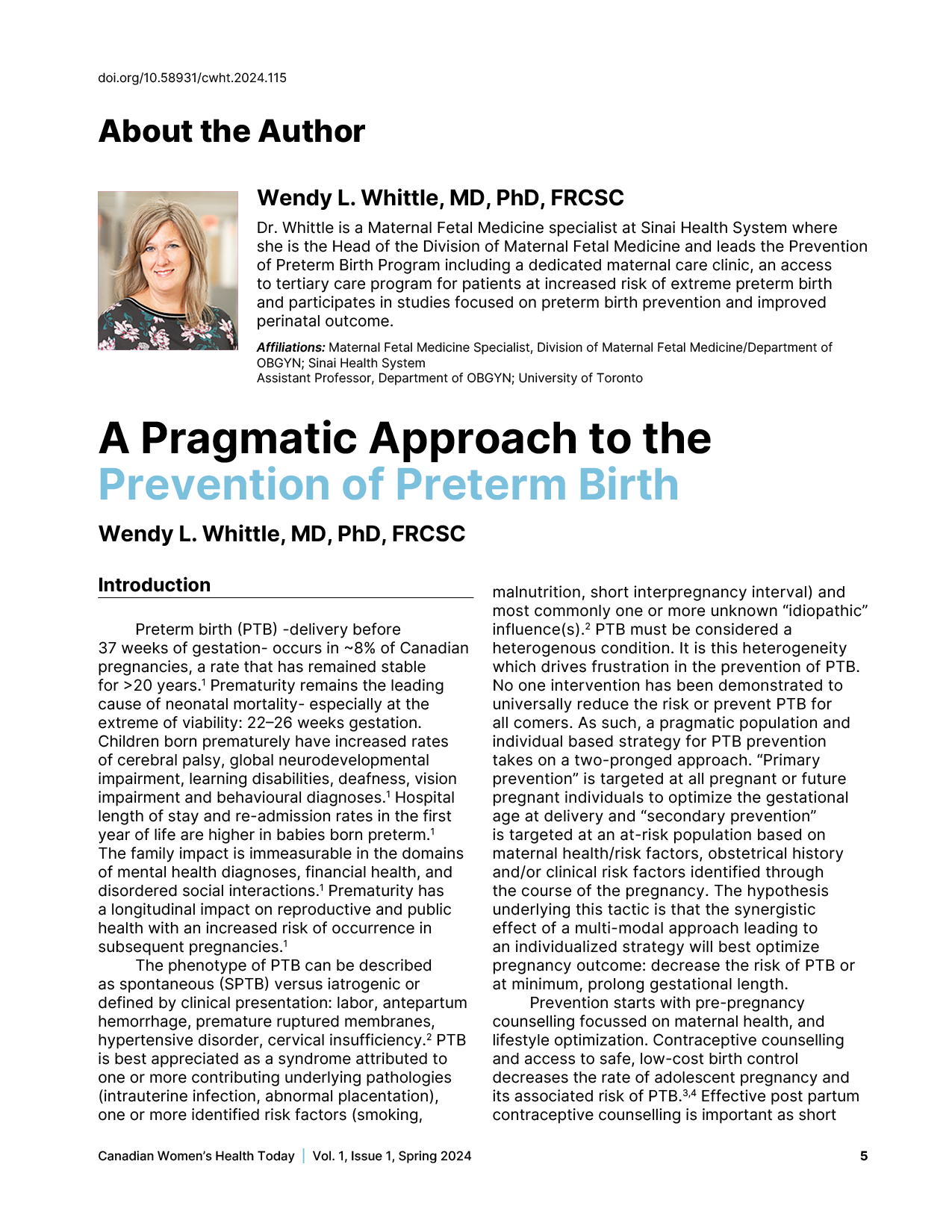A Pragmatic Approach to the Prevention of Preterm Birth
DOI:
https://doi.org/10.58931/cwht.2024.115Abstract
Preterm birth (PTB) -delivery before 37 weeks of gestation- occurs in ~8% of Canadian pregnancies, a rate that has remained stable for >20 years. Prematurity remains the leading cause of neonatal mortality- especially at the extreme of viability: 22–26 weeks gestation. Children born prematurely have increased rates of cerebral palsy, global neurodevelopmental impairment, learning disabilities, deafness, vision impairment and behavioural diagnoses. Hospital length of stay and re-admission rates in the first year of life are higher in babies born preterm. The family impact is immeasurable in the domains of mental health diagnoses, financial health, and disordered social interactions. Prematurity has a longitudinal impact on reproductive and public health with an increased risk of occurrence in subsequent pregnancies.
References
Shah PS, McDonald SD, Barrett J, Synnes A, Robson K, Foster J, Pasquier JC, Joseph KS, Piedboeuf B, Lacaze-Masmonteil T, O’Brien K, Shivananda S, Chaillet N, Pechlivanoglou P; Canadian Preterm Birth Network Investigators. The Canadian Preterm Birth Network: a study protocol for improving outcomes for preterm infants and their families. CMAJ Open. 2018 Jan 18;6(1):E44-E49. doi: 10.9778/cmajo.20170128. PMID: 29348260; PMCID: PMC5878956.
Ferreira A, Bernardes J, Gonçalves H. Risk Scoring Systems for Preterm Birth and Their Performance: A Systematic Review. J Clin Med. 2023 Jun 28;12(13):4360. doi: 10.3390/jcm12134360. PMID: 37445395; PMCID: PMC10342801.
Badreldeen Ahmed, Mandy Abushama & Justin C. Konje (2023) Prevention of spontaneous preterm delivery – an update on where we are today, The Journal of Maternal, Fetal & Neonatal Medicine, 36:1, 2183756, DOI: 10.1080/14767058.2023.2183756.
Medley N, Vogel JP, Care A, Alfirevic Z. Interventions during pregnancy to prevent preterm birth: an overview of Cochrane systematic reviews. Cochrane Database of Systematic Reviews 2018, Issue 11. Art. No.: CD012505. DOI: 10.1002/14651858.CD012505.pub2.
Xu YP, Hu JM, Huang YQ, Shi LP. Maternal Ureaplasma exposure during pregnancy and the risk of preterm birth and BPD: a meta-analysis. Arch Gynecol Obstet. 2022 Dec;306(6):1863-1872. doi: 10.1007/s00404-022-06491-7. Epub 2022 Mar 12. PMID: 35277749.
Yang S, Reid G, Challis JR, Kim SO, Gloor GB, Bocking AD. Is there a role for probiotics in the prevention of preterm birth? Front Immunol. 2015 Feb 17;6:62. doi: 10.3389/fimmu.2015.00062. PMID: 25741339; PMCID: PMC4330906.
Rolnik DL, Nicolaides KH, Poon LC. Prevention of preeclampsia with aspirin. Am J Obstet Gynecol. 2022 Feb;226(2S):S1108-S1119. doi: 10.1016/j.ajog.2020.08.045. Epub 2020 Aug 21. PMID: 32835720.
https:// fetalmedicine.org/research/assess/preeclampsia/first-trimester.
Brosens I, Puttemans P, Benagiano G. Placental bed research: I. The placental bed: from spiral arteries remodeling to the great obstetrical syndromes. Am J Obstet Gynecol. 2019 Nov;221(5):437-456. doi: 10.1016/j.ajog.2019.05.044. Epub 2019 Jun 1. PMID: 31163132.
Conde-Agudelo A, Romero R. Does vaginal progesterone prevent recurrent preterm birth in women with a singleton gestation and a history of spontaneous preterm birth? Evidence from a systematic review and meta-analysis. Am J Obstet Gynecol. 2022 Sep;227(3):440-461.e2. doi: 10.1016/j.ajog.2022.04.023. Epub 2022 Apr 20. PMID: 35460628; PMCID: PMC9420758.
Wennerholm UB, Bergman L, Kuusela P, Ljungström E, Möller AC, Hongslo Vala C, Ekelund AC, Liljegren A, Petzold M, Sjögren P, Svensson M, Strandell A, Jacobsson B. Progesterone, cerclage, pessary, or acetylsalicylic acid for prevention of preterm birth in singleton and multifetal pregnancies - A systematic review and meta-analyses. Front Med (Lausanne). 2023 Feb 28;10:1111315. doi: 10.3389/fmed.2023.1111315. PMID: 36936217; PMCID: PMC10015499.
McAuliffe L, Issah A, Diacci R, Williams KP, Aubin AM, Phung J, Wang C, Maouris A, Leathersich S, Maouris P, Pennell CE. McDonald versus Shirodkar cerclage technique in the prevention of preterm birth: A systematic review and meta-analysis. BJOG. 2023 Jun;130(7):702-712. doi: 10.1111/1471-0528.17438. Epub 2023 Mar 8. PMID: 36810870.
Campbell F, Salam S, Sutton A, Jayasooriya SM, Mitchell C, Amabebe E, Balen J, Gillespie BM, Parris K, Soma-Pillay P, Chauke L, Narice B, Anumba DO. Interventions for the prevention of spontaneous preterm birth: a scoping review of systematic reviews. BMJ Open. 2022 May 13;12(5):e052576. doi: 10.1136/bmjopen-2021-052576. PMID: 35568487; PMCID: PMC9109033.

